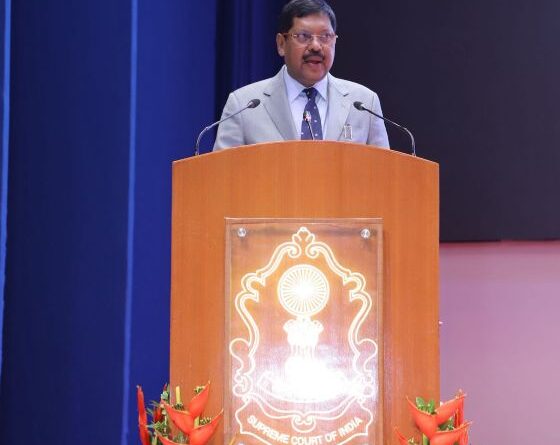Let Technology Reflect Constitutional Morality—Empower the Girl Child, Says CJI Gavai
(By Syed Ali Taher Abedi)
New Delhi, Oct 11 — Chief Justice of India Dr. B.R. Gavai on Saturday issued a clarion call for a unified institutional response to safeguard the rights of the girl child, warning that the digital age has ushered in new and sophisticated threats to her safety and dignity.
“The threats faced by young girls are no longer confined to physical spaces, they extend into the vast and often unregulated digital world.”
Delivering the inaugural address at the 10th Annual Stakeholders’ Conclave on Safeguarding the Girl Child, organized by the Supreme Court of India, the CJI underscored the urgent need to confront emerging challenges such as online harassment, cyberbullying, digital stalking, misuse of personal data, and deepfake imagery—phenomena that have evolved in both scale and complexity.
“Our institutions, policy frameworks, and enforcement authorities must therefore be attuned to the realities of our times. Training programmes for police officers, educators, health professionals, and local administrators should consequently incorporate a sensitive approach, equipping them to respond with empathy, nuance, and contextual understanding. Laws addressing online sexual exploitation, digital trafficking, and cyber harassment must be paired with effective enforcement, education, and awareness initiatives. Protecting the girl child must become a core priority of digital governance, ensuring that technological progress is accompanied by ethical safeguards.”
“The strength and destiny of any nation is inextricably linked to the well-being of its daughters,” Justice Gavai declared, emphasizing that technology must become a tool of liberation, not oppression.
“Safeguarding a girl child, in this context, means nurturing her voice, curiosity, ambitions, and sense of self-worth. It means ensuring she can learn without fear, dream without limitation, and participate fully in the life of her community and nation. When our laws, policies, and institutions create these conditions, they not only protect an individual girl but uphold the very promise of our Republic.”
He invoked the Constitutional mandate, citing Articles 14, 15(3), 19, and 21, which place a solemn obligation on the State and public institutions to create enabling conditions and prevent harm to the girl child. The Constituent Assembly, he noted, had envisioned the State’s role in ensuring education, nutrition, and healthcare for all children.
“When our laws, policies, and institutions create these conditions, they not only protect an individual girl but uphold the very promise of our Republic.”
Justice Gavai lamented that many girls in India continue to be denied their fundamental rights, exposing them to disproportionately high risks of sexual abuse, exploitation, and harmful practices such as sex-selective abortions, trafficking, and child marriage.
He also drew attention to intersectional discrimination, stating that girls from marginalized castes or those living with disabilities face compounded disadvantages. To address this, he advocated for sensitivity training across key sectors—including law enforcement, education, healthcare, and local administration.
“Too often, well-meaning citizens, upon encountering a trafficked, abandoned, or abused girl, simply do not know what exactly they can do. This lack of awareness limits the effectiveness of existing frameworks and delays timely care and rehabilitation for the affected child.”
The CJI further stressed the need for public awareness campaigns to educate citizens about child protection laws and welfare schemes, and to build community capacity to respond to child abuse, begging, sexual exploitation, and trafficking.
“Awareness programmes must reach rural communities, schools, and local self-governments, empowering the citizens to act knowledgeably and responsibly. Our efforts must reach every corner of the country, and should not be limited to only the national capital.”
Calling for constant vigilance, Justice Gavai urged all stakeholders—judiciary, legislature, executive, civil society, and media—to work in concert to ensure that every girl child in India is truly empowered and protected under the Constitution.
“While the judiciary can play a role in reaffirming rights and ensuring accountability, the primary responsibility for implementing these rights rests with the executive. In protecting the rights of children, especially girls, the executive plays the most crucial role as they are the primary stakeholders in these issues.”
In conclusion, the chief Justice quoted Rabindranath Tagore’s poem “Where the Mind is without fear “saying it captures the essence of what the nation seeks to achieve by safeguarding the girl child “He dreamt of a nation “where the mind is without fear and the head is held high; where knowledge is free.” That vision remains incomplete so long as any girl in our country lives in fear: fear of violence, of discrimination, or of being denied the chance to learn and to dream.”
He also said that “That vision remains incomplete so long as any girl in our country lives in fear: fear of violence, of discrimination, or of being denied the chance to learn and to dream. 31. To secure her safety is not merely to protect her body, but to free her spirit. To create a society where she can hold her head high in dignity, and where her aspirations are nourished by education and equality. Tagore’s warning against the “dreary desert sand of dead habit” reminds us that we must confront and overcome the deep-rooted patriarchal customs that continue to deny girls their rightful place.”
He said that the day coincided with the international Girl Child Day



